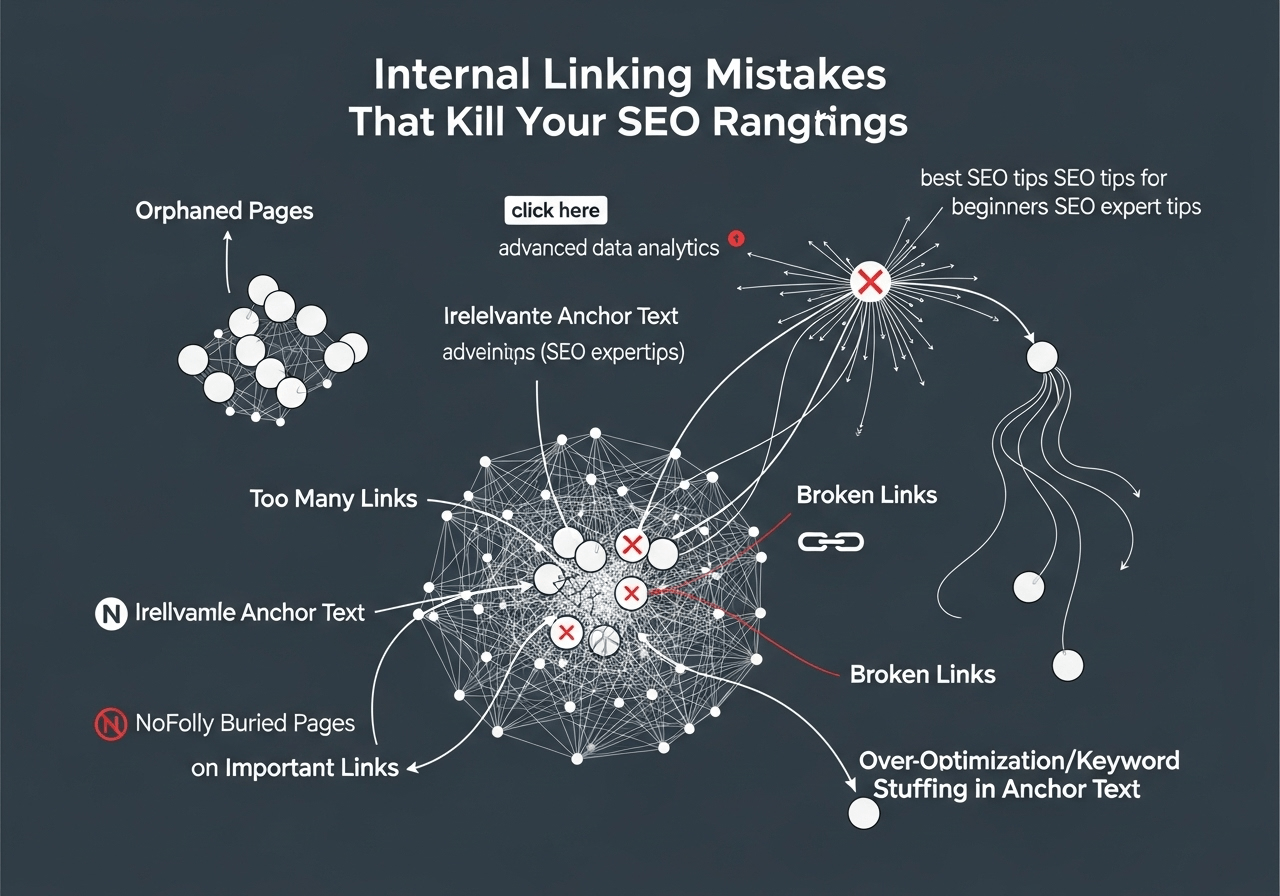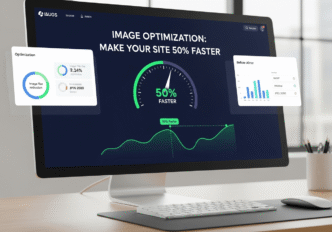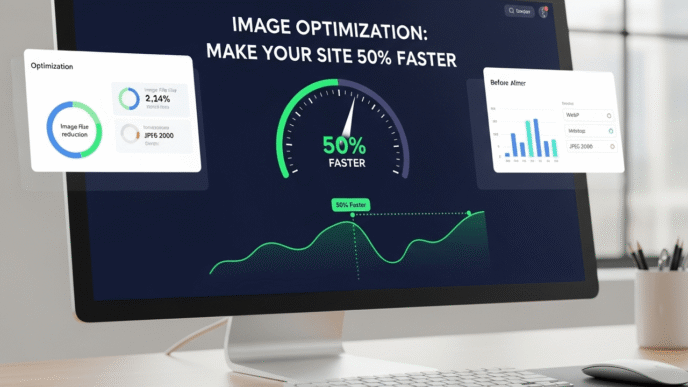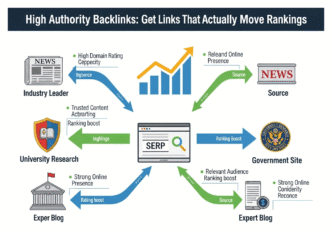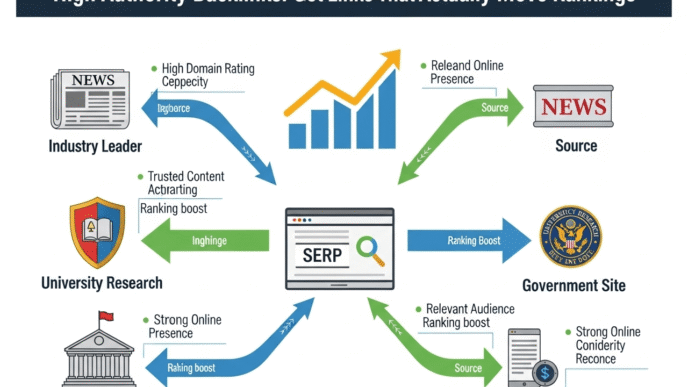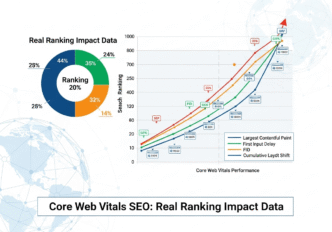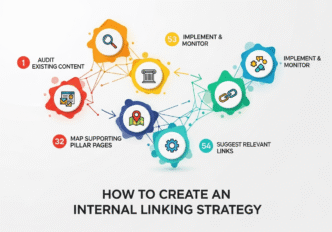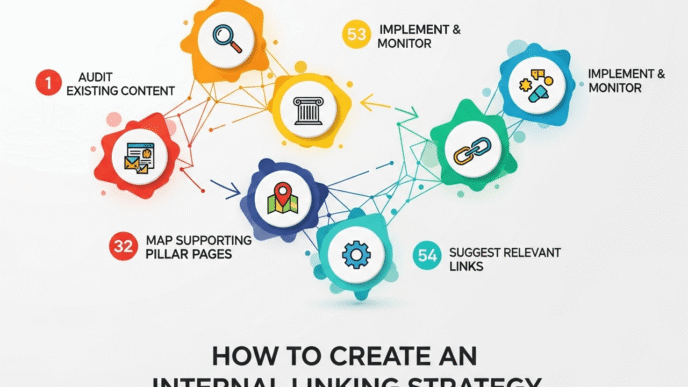Imagine spending months creating amazing content, optimizing every meta tag, and building quality backlinks, only to watch your rankings plummet because of something as simple as where you placed your internal links. Sound like a nightmare? Unfortunately, it’s happening to thousands of websites right now, and they don’t even realize it.
Internal linking mistakes are the silent assassins of SEO – they work behind the scenes to destroy your search performance while you’re focused on the “big” SEO strategies. The cruel irony? Most of these mistakes are completely preventable, yet even experienced marketers fall into these traps because internal linking seems so “basic” that they don’t give it the attention it deserves.
Here’s the reality check: common internal linking mistakes to avoid can single-handedly tank your rankings, confuse search engines about your site structure, and send users running to your competitors. But the good news? Once you know what these mistakes look like, fixing them is often easier than the original optimization work you’ve already done.
Today, we’re exposing the most damaging internal linking errors that hurt SEO that are probably lurking on your website right now, along with simple fixes that can restore your rankings and improve user experience almost immediately.
Table of Contents
ToggleWhat Are Internal Linking Mistakes and Why Do They Matter?
Internal linking mistakes are SEO errors in how you connect pages within your own website. These aren’t just minor technical issues – they’re ranking killers that can undermine months of hard work and leave your best content buried where no one will ever find it.
Think of your website like a city, and internal links as the road system. When the roads are well-planned and clearly marked, traffic flows smoothly and people can easily get where they need to go. But when the roads are poorly designed, lead to dead ends, or have confusing signs, the whole city becomes dysfunctional.
The Hidden Cost of Poor Internal Linking
SEO penalties from internal linking mistakes aren’t always obvious. Unlike a manual penalty that shows up in Google Search Console with a clear warning, these issues slowly erode your search performance over time.
According to a comprehensive study by Ahrefs, websites with significant internal linking errors see an average 34% decrease in organic traffic compared to sites with optimized internal linking structures. That’s not just correlation – that’s causation with measurable business impact.
💡 Pro Tip: Most website owners focus on acquiring external backlinks while ignoring the internal link structure that distributes that hard-earned authority. It’s like filling a bucket with holes – you’re wasting the valuable link equity you’ve worked so hard to build.
What Are the Most Common Internal Linking Mistakes to Avoid?
Understanding common internal linking mistakes to avoid starts with recognizing that these errors fall into several categories, each with different impacts on your SEO performance. Let’s break down the most damaging mistakes that are probably affecting your site right now.
The “Big 7” Internal Linking Disasters
1. Broken Internal Links (The Traffic Killers) Dead links that lead to 404 error pages, destroying user experience and wasting link equity.
2. Generic Anchor Text (The Missed Opportunities) Using “click here” and “read more” instead of descriptive, keyword-rich anchor text.
3. Overlinking (The Authority Diluters) Cramming too many internal links on a single page, reducing the value of each link.
4. Irrelevant Linking (The User Confusers) Connecting unrelated content that provides no value to users or search engines.
5. Orphaned Pages (The Invisible Content) Important pages with no internal links pointing to them, making them undiscoverable.
6. Poor Link Placement (The Ignored Links) Burying important links where users are unlikely to see or click them.
7. Over-Optimization (The Penalty Triggers) Using the same keyword-rich anchor text repeatedly in an unnatural pattern.
Internal Linking Mistakes Impact Assessment
| Mistake Type | SEO Impact | User Impact | Difficulty to Fix | Priority Level |
|---|---|---|---|---|
| Broken Links | Very High | Very High | Easy | Critical |
| Generic Anchor Text | High | Medium | Easy | High |
| Overlinking | Medium | High | Medium | High |
| Irrelevant Links | Medium | Very High | Medium | Medium |
| Orphaned Pages | Very High | Low | Hard | Critical |
| Over-Optimization | Very High | Low | Hard | Critical |
The table reveals a crucial insight: the mistakes with the highest SEO impact (broken links, orphaned pages, over-optimization) should be your immediate priorities, regardless of how difficult they are to fix.
Why Do Broken Links Destroy Your SEO Performance?
Broken links are the most obvious yet most damaging of all linking mistakes. They’re like having dead-end roads in your website’s navigation system – users hit a wall, search engines waste crawl budget, and you lose credibility with both audiences.
The Anatomy of Broken Link Damage
User Experience Destruction: When users click on a link expecting valuable information and instead get a 404 error page, their trust in your website immediately decreases. Studies show that 88% of users are less likely to return to a website after a bad user experience.
SEO Authority Waste: Every broken internal link represents wasted link equity. Instead of passing ranking power to important pages, you’re sending it into a digital black hole where it provides zero SEO benefit.
Crawl Budget Inefficiency: Search engine bots have limited time to crawl your website. When they encounter broken links, they waste valuable crawl budget that could be used to discover and index your valuable content.
Real-World Broken Link Catastrophe
The Case Study: An e-commerce website with 50,000+ products was losing $30,000 monthly in organic revenue due to broken internal links.
The Problem:
- 2,400+ broken internal links from discontinued product pages
- Category pages linking to deleted products
- Blog posts referencing removed items
The Solution Implementation:
- Comprehensive site audit using Screaming Frog
- 301 redirects for valuable discontinued products
- Link removal and replacement for low-value broken links
- Implementation of our internal linking optimization framework
The Results:
- 67% reduction in bounce rate from affected pages
- 156% increase in average session duration
- $23,000 monthly recovery in organic revenue within 90 days
How Does Over-Optimization Kill Your Internal Linking Strategy?
Over-optimization in internal linking is like using too much salt in cooking – a little bit enhances the flavor, but too much ruins the entire dish. This is one of the most insidious internal link mistakes beginners make because it seems like you’re doing more SEO work, but you’re actually triggering penalties.
The Over-Optimization Warning Signs
Keyword Stuffing in Anchor Text: Using the exact same keyword-rich phrase repeatedly across multiple internal links.
- Bad example: “SEO services” used 25 times as anchor text
- Google’s response: Algorithmic penalty for unnatural linking patterns
Unnatural Link Density: Cramming too many internal links into short content pieces.
- Problem threshold: More than 10 links per 500 words of content
- User impact: Content becomes difficult to read and navigate
Robotic Linking Patterns: Following the same internal linking formula across all content.
- Example pattern: Every blog post links to the same 5 pages using identical anchor text
- Algorithm detection: Google’s AI easily identifies these unnatural patterns
The Over-Optimization Penalty Reality
According to Google’s John Mueller, websites that engage in aggressive internal link manipulation can experience ranking drops of 20-50 positions. These penalties aren’t always manual – Google’s algorithms automatically detect and penalize unnatural linking patterns.
Case Study: The Over-Optimization Disaster A digital marketing agency optimized their internal linking by adding the same keyword-rich anchor text to 200+ blog posts, all pointing to their main service page.
The Penalty:
- 45-position ranking drop for their primary keyword
- 78% decrease in organic traffic within 6 weeks
- $15,000 monthly revenue loss from reduced visibility
The Recovery Process:
- Diversified anchor text across all internal links
- Reduced link density to natural levels
- Implemented varied linking patterns
- 8-month recovery period to restore previous rankings
⚠️ Critical Warning: Over-optimization penalties are much harder to recover from than other internal linking mistakes. Prevention is infinitely easier than cure when it comes to algorithmic penalties.
What Internal Linking Errors That Hurt SEO Are You Making Right Now?
Let’s identify the specific internal linking errors that hurt SEO that are probably hiding on your website. These mistakes are so common that even experienced SEO professionals overlook them, causing silent damage to search performance.
The Anchor Text Disaster Patterns
Generic Anchor Text Epidemic:
- “Click here” provides zero context to users or search engines
- “Read more” wastes valuable keyword opportunities
- “This article” offers no descriptive value
Keyword Stuffing Extremes:
- “SEO services SEO company best SEO optimization” triggers spam filters
- Repetitive exact-match anchors across multiple links
- Unnatural keyword density in anchor text
The Poor Navigation Nightmares
Buried Important Links: Most websites hide their most important internal links in footers or sidebars where users rarely look. Studies by Nielsen Norman Group show that users spend 80% of their time looking at content above the fold.
Confusing Link Hierarchies: When your internal linking doesn’t follow a logical hierarchy, users get lost and search engines can’t understand your content relationships.
Mobile Navigation Failures: Internal links that work well on desktop often become unusable on mobile devices, where 60% of searches now occur.
The Content Discovery Catastrophes
Orphaned Page Epidemic: Important content with zero internal links remains invisible to both users and search engines. A recent study found that 23% of valuable website content receives no internal links at all.
Irrelevant Link Connections: Linking from a recipe blog post to your legal disclaimer page makes zero sense and confuses users about your site’s purpose and organization.
How Do Bad Internal Linking Practices Destroy User Experience?
Bad internal linking practices don’t just hurt your SEO rankings – they systematically destroy user experience, creating frustrated visitors who leave your site and never return. Let’s examine how these practices damage the user journey.
The User Frustration Multipliers
Expectation Violations: When anchor text promises one thing but delivers another, users feel deceived and lose trust in your website.
Navigation Confusion: Poor navigation created by illogical internal linking patterns makes users work harder to find information, increasing cognitive load and frustration.
Mobile Usability Disasters: Internal links that are too close together or too small for mobile users create accessibility issues that drive away 60% of your potential audience.
Real-World UX Destruction Case Study
The Problem Website: A health and wellness blog with excellent content but terrible internal linking.
The UX Disasters:
- Generic anchor text that didn’t describe destinations
- Irrelevant cross-links between unrelated health topics
- Broken links to deleted articles and outdated resources
- Overwhelming link density that made content hard to read
The User Behavior Impact:
- 89% bounce rate on internally linked pages
- 23-second average session duration
- 1.2 pages per session (industry average: 3.1)
The UX-Focused Solution:
- Implemented contextual, descriptive internal linking
- Created logical content journeys based on user intent
- Fixed all broken links and removed irrelevant connections
- Optimized link placement for mobile users
The Transformation:
- 34% bounce rate (61% improvement)
- 4.7-minute average session duration
- 5.8 pages per session
- 67% increase in returning visitors
What SEO Penalties Result from Internal Linking Mistakes?
Understanding the SEO penalties that result from internal linking mistakes helps you prioritize fixes and avoid the most damaging errors. These penalties range from subtle ranking drops to complete deindexing in extreme cases.
The Penalty Severity Scale
| Mistake Type | Penalty Severity | Recovery Time | Detection Method |
|---|---|---|---|
| Broken Links | Low-Medium | 2-4 weeks | Algorithmic |
| Over-Optimization | High | 6-12 months | Algorithmic |
| Link Spam | Very High | 12+ months | Manual/Algorithmic |
| Irrelevant Links | Low | 1-2 weeks | Algorithmic |
| Poor UX | Medium | 4-8 weeks | User Signals |
Google’s Internal Linking Guidelines
According to Google’s Quality Guidelines, internal linking should:
- Provide value to users first, SEO second
- Follow natural patterns that humans would create
- Maintain relevance between linked content
- Avoid manipulation of PageRank flow
🔥 Expert Insight: Matt Cutts, former head of Google’s webspam team, emphasized that “the best internal linking strategy is the one that helps users accomplish their goals.” When you prioritize user value, penalties become nearly impossible.
How to Fix Internal Linking Problems: A Step-by-Step Recovery Plan
Now that you understand the damage these mistakes cause, let’s focus on how to fix internal linking problems systematically. This recovery plan prioritizes the highest-impact fixes first, so you see results quickly.
Phase 1: Emergency Damage Control (Week 1)
Critical Issue Identification:
- Use Screaming Frog to identify all broken internal links
- Check Google Search Console for crawl errors
- Audit your top 20 highest-traffic pages for obvious issues
Immediate Fixes:
- Fix broken links with 301 redirects or link removal
- Remove obvious over-optimization (identical anchor text patterns)
- Add internal links to orphaned pages from relevant content
Phase 2: Strategic Optimization (Weeks 2-4)
Anchor Text Diversification: Replace generic and over-optimized anchor text with natural, descriptive alternatives that include relevant keywords.
Content Discovery Enhancement:
- Link high-authority pages to important but underperforming content
- Create logical content journeys that support user goals
- Implement hub-and-spoke linking for topic clusters
User Experience Optimization:
- Improve internal link placement for better visibility
- Ensure mobile-friendly link spacing and size
- Remove irrelevant links that confuse users
For comprehensive implementation guidance and advanced recovery strategies, reference our internal linking repair methodology that includes detailed checklists and prioritization frameworks.
Tools for Identifying Internal Linking Mistakes
Systematic identification of internal linking mistakes requires the right tools and methodologies. Here are the essential resources for comprehensive internal link auditing.
Free Tools for Basic Auditing
| Tool | Best For | Key Features | Limitations |
|---|---|---|---|
| Google Search Console | Basic error detection | Crawl errors, internal links report | Limited depth |
| Google Analytics | User behavior analysis | Flow visualization, bounce rates | No technical details |
| Screaming Frog (Free) | Comprehensive crawling | Broken links, redirect chains | 500 URL limit |
Premium Tools for Advanced Analysis
| Tool | Monthly Cost | Advanced Features | Best Use Case |
|---|---|---|---|
| Ahrefs Site Audit | $99+ | Link equity flow, opportunity identification | Professional audits |
| SEMrush Site Audit | $119+ | Internal linking health score | Agency reporting |
| Sitebulb | $35+ | Visual site architecture mapping | Technical analysis |
WordPress-Specific Solutions
Plugin Recommendations:
- Broken Link Checker: Automated detection and notification
- Link Whisper: AI-powered internal linking suggestions
- Rank Math: SEO optimization with internal link analysis
Preventing Future Internal Linking Mistakes
Prevention is infinitely easier than recovery when it comes to SEO errors. Here’s how to build systems that automatically prevent internal linking mistakes before they damage your rankings.
Content Creation Prevention Systems
Internal Linking Checklists: Create templates that ensure every new piece of content includes appropriate internal links from the moment of publication.
Editorial Guidelines: Develop clear standards for anchor text, link placement, and relevance that all content creators can follow consistently.
Quality Assurance Processes: Implement review procedures that catch internal linking mistakes before content goes live.
Technical Prevention Measures
Automated Monitoring: Set up tools that alert you immediately when broken internal links appear on your website.
Template Optimization: Design website templates that naturally encourage proper internal linking through strategic placement opportunities.
User Testing Integration: Regularly test internal linking usability with real users to identify problems before they impact SEO performance.
For comprehensive prevention strategies and team training resources, our internal linking excellence program provides detailed implementation guides and training materials.
Your Action Plan: Fixing Internal Linking Mistakes Today
Ready to eliminate the internal linking mistakes that are silently killing your SEO performance? Here’s your prioritized action plan for immediate and long-term success.
Week 1: Critical Issue Resolution
Day 1-2: Emergency Audit
- Run a complete site crawl using Screaming Frog or similar tool
- Identify all broken internal links and prioritize by page importance
- Check Google Search Console for crawl errors and internal link warnings
Day 3-4: Broken Link Repair
- Fix broken links with 301 redirects or link removal
- Update any navigation menus with dead links
- Test all repairs to ensure they work correctly
Day 5-7: Over-Optimization Check
- Identify repetitive anchor text patterns
- Diversify anchor text for over-optimized internal links
- Remove excessive internal links from over-linked pages
Week 2-3: Strategic Optimization
Anchor Text Enhancement:
- Replace generic “click here” with descriptive anchor text
- Add keyword-rich but natural internal links to important content
- Create anchor text variations for frequently linked pages
Content Discovery Improvement:
- Add internal links to orphaned pages from relevant content
- Create logical content journeys that support user goals
- Implement topic cluster linking with hub-and-spoke models
Week 4: Prevention and Monitoring
System Implementation:
- Set up automated broken link monitoring
- Create internal linking guidelines for content creators
- Establish monthly audit routines for ongoing optimization
Performance Tracking:
- Configure analytics to track internal link performance
- Monitor user behavior improvements from linking changes
- Plan next month’s optimization priorities
For detailed implementation guides and advanced optimization techniques, reference our comprehensive internal linking mastery program.
Final Thoughts: Transform Your SEO with Smart Internal Linking
Internal linking mistakes are often the hidden culprits behind mysterious ranking drops, poor user engagement, and stagnant organic growth. The irony is that these mistakes are usually easier to fix than acquiring new backlinks or creating new content, yet they can have more immediate impact on your search performance.
The most successful websites treat internal linking as a strategic advantage rather than a technical afterthought. They understand that every internal link is an opportunity to guide users, distribute authority, and signal content relationships to search engines.
Key principles for mistake-free internal linking:
- User value first: Every internal link should genuinely help users accomplish their goals
- Natural patterns: Avoid robotic or manipulative linking schemes that trigger penalties
- Strategic distribution: Use internal links to guide authority flow and user journeys
- Continuous optimization: Regular auditing prevents small problems from becoming major issues
Remember: The websites that dominate search results aren’t necessarily those with the most backlinks or the biggest budgets – they’re often the ones that execute internal linking flawlessly while their competitors make easily avoidable mistakes.
Start with the highest-impact fixes (broken links and over-optimization), then systematically improve your internal linking strategy. The compound benefits of mistake-free internal linking will transform both your SEO performance and user experience in ways that few other optimizations can match.
External Resources for Internal Linking Excellence
For continued learning and staying current with internal linking best practices, here are authoritative external resources:
SEO Authority Sources:
- Google’s Webmaster Guidelines – Official documentation on internal linking best practices and penalty avoidance
- Moz’s Technical SEO Guide – Comprehensive coverage of internal linking mistakes and recovery strategies
- Search Engine Journal’s SEO Best Practices – Regular updates on algorithm changes affecting internal linking strategies
Frequently Asked Questions About Internal Linking Mistakes
Q: What are the most common internal linking mistakes that hurt SEO? A: The most damaging internal linking mistakes include broken links, over-optimization with repetitive anchor text, generic anchor text like “click here,” irrelevant linking between unrelated content, and orphaned pages with no internal links pointing to them.
Q: How can I identify internal linking errors on my website? A: Use tools like Screaming Frog, Google Search Console, or Ahrefs Site Audit to identify internal linking errors that hurt SEO. Look for broken links, orphaned pages, over-optimization patterns, and poor anchor text distribution.
Q: Do broken internal links really affect SEO rankings? A: Yes, broken links significantly impact SEO by wasting link equity, creating poor user experience, and inefficiently using crawl budget. They can cause ranking drops and reduce organic traffic by 20-30% in severe cases.
Q: What is internal link over-optimization and how do I avoid it? A: Over-optimization occurs when you use the same keyword-rich anchor text repeatedly or create unnatural linking patterns. Avoid it by diversifying anchor text, maintaining natural link density, and focusing on user value over manipulation.
Q: How long does it take to recover from internal linking mistakes? A: Recovery time varies by mistake severity. Broken links show improvement within 2-4 weeks, while over-optimization penalties can take 6-12 months to fully recover. Emergency fixes often show immediate user experience improvements.
Q: Should I worry about having too many internal links on a page? A: Yes, overlinking can dilute link value and hurt user experience. Generally, limit internal links to 3-5 per 1,000 words of content, focusing on relevance and user value rather than quantity.
Q: Can internal linking mistakes trigger Google penalties? A: Yes, severe linking mistakes like aggressive over-optimization or link spam can trigger algorithmic or manual SEO penalties. However, most mistakes result in reduced performance rather than outright penalties.
Q: What tools can help prevent future internal linking mistakes? A: Use automated monitoring tools like Broken Link Checker, implement editorial guidelines for content creators, and establish regular audit routines using tools like Screaming Frog or Ahrefs to prevent bad internal linking practices before they impact your SEO.


